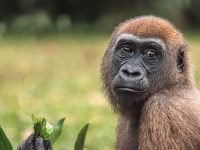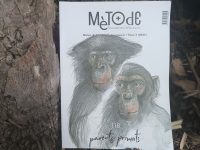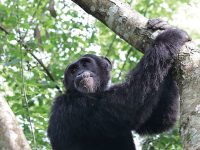A primatological perspective on human cultural origins
When did cumulative culture evolved in our lineage
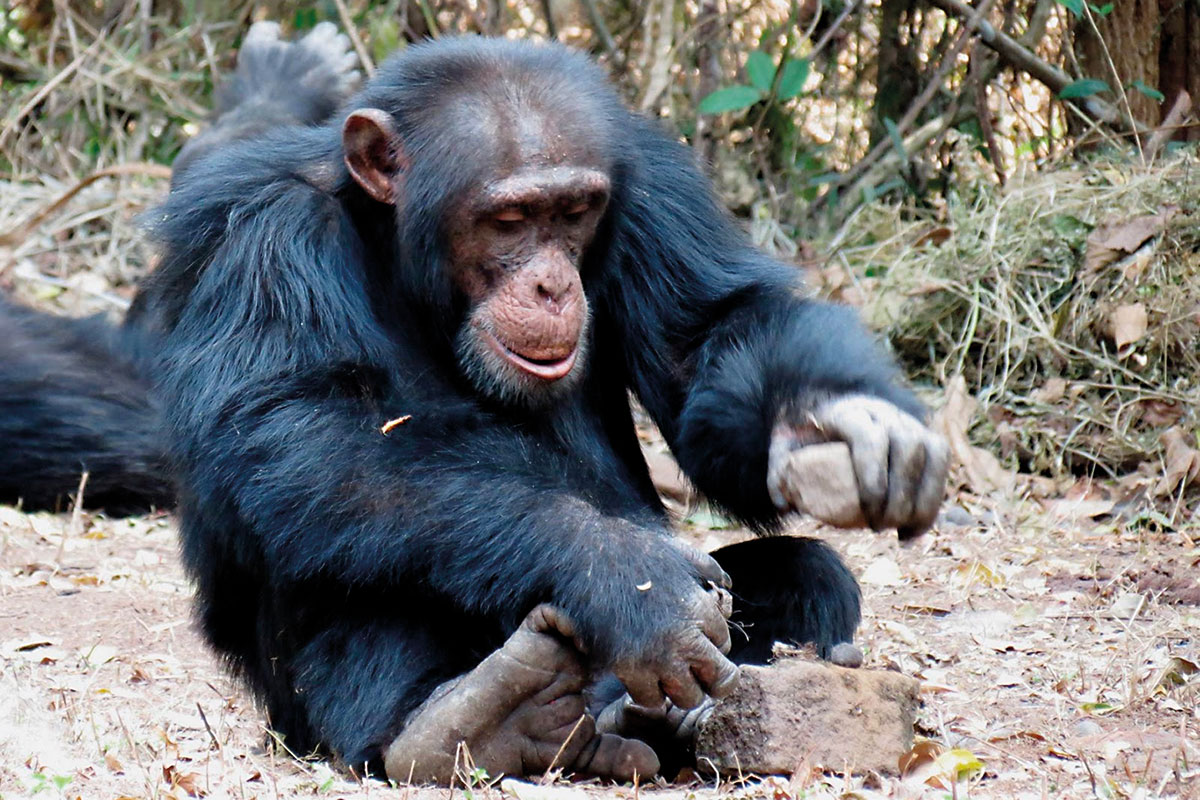
Humans are one of the most successful species in the planet as we inhabit almost every ecosystem on Earth. This success has been attributed to our cultural proficiency, which allows us to store in the collective minds of our populations complex knowledge that no single individual could innovate on its own. In this way, we acquire most of our behavioural repertoire from experts in our communities and, contrary to any other species, we build upon this collectively-stored information to create novel solutions to face ever-more-challenging problems. This ratcheting of behavioural complexity has led to our culture being coined cumulative. The fact that not even our closest living relatives, the great apes, possess this type of culture begs the question of when did cumulative culture evolve in our lineage. In this piece, I discuss how the field of experimental primate archaeology has contributed to this question by describing several stone-tool experiments conducted with great apes.
Keywords: cumulative culture, stone tools, great apes, experimental primate archaeology, human origins.
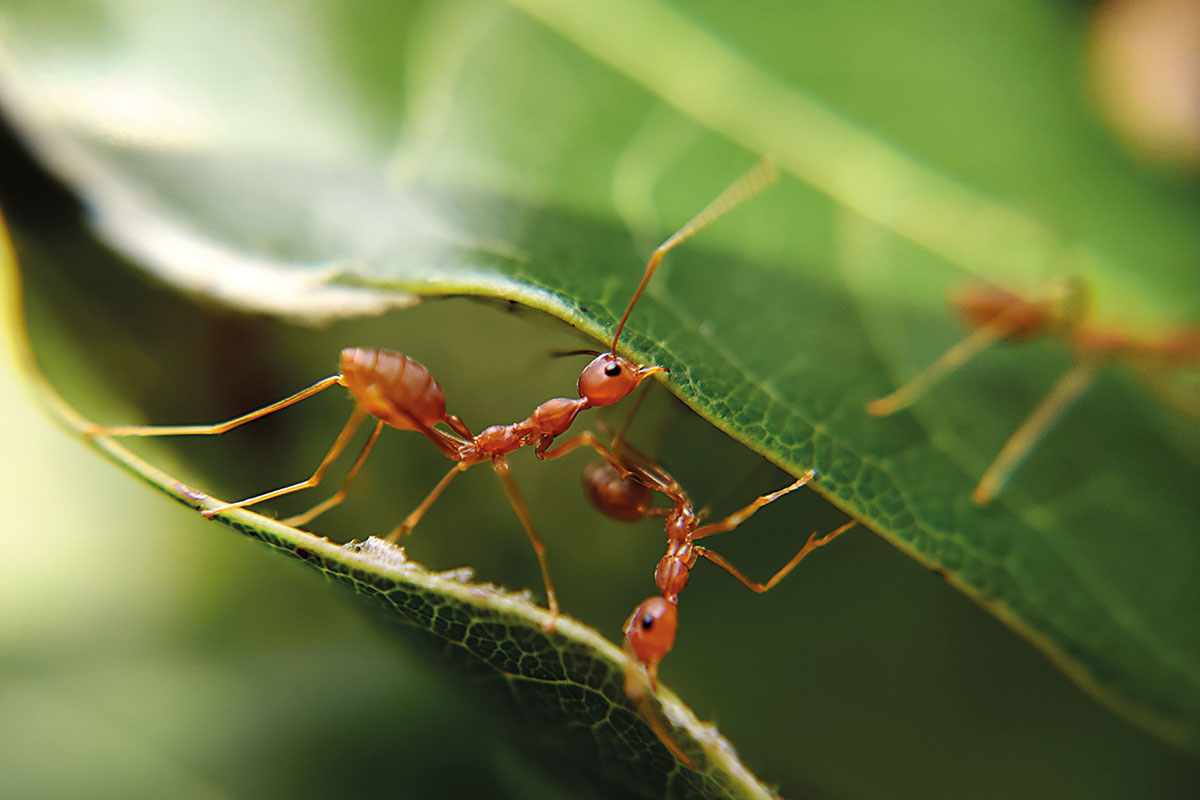
Similar to ants, humans are one of the species with the highest ecological success: we inhabit almost every ecosystem on Earth. Contrary to ants, however, our adaptations to different environments do not rely in a huge diversity of species or in eusociality. / M. D. Jerry
Similar to ants, humans are one of the species with the highest ecological success: we inhabit almost every ecosystem on Earth, and occasionally even go beyond our planetary borders. Contrary to ants however, our adaptations to different environments do not rely in a huge diversity of species (there are more than 14,000 species of ants) or in eusociality, where reproduction is only carried out by one or a few individuals, generations overlap, and non-reproductive individuals cooperatively take care of the brood. The secret of humans’ ecological success is our cultural proficiency.
Human culture spans all behavioural domains and the vast majority of the human behavioural repertoire is cultural to some degree. In the scientific literature, culture is defined as all group-typical behavioural patterns shared by members of a community that are to some degree reliant on socially transmitted information (Laland & Hoppitt, 2003). According to this definition, culture per se is not limited to our species. Chimpanzees (Pan troglodytes) in different communities use slight variations of the same gestures during sexual solicitation as well as the same gestures in different contexts (Badihi et al., 2023) much like the same word sometimes has different meanings in different languages or nodding means different things in different countries (in Bulgaria it means «no»). Similarly to how musical trends are transmitted between cultures and countries, humpback whales (Megaptera novaeangliae) sing different songs in different populations of the world and when they encounter new songs sang by other groups, they quickly acquire this new song in what is known as a revolution song (Zandberg et al., 2021). Birds have also been shown to express cultural traits. Female blue tits (Cyanistes caeruleus) in different communities use different materials to pad their nests. These material preferences are stable over time and are not explained by the abundance of specific types of vegetation (Breen, 2021). Although the list of cultural species is evergrowing and includes almost all major animal taxa, human culture has some characteristics that are yet to be found in any other species and that make it unique.
Human culture is cumulative. This means that individuals copy and learn behaviours from one another, progressively increasing the complexity and efficiency of behaviours over time due to the accumulation of intentional – or unintentional – modifications and innovations (Boyd & Richerson, 1996). Cumulative culture requires specific types of learning such as imitation that ensure the reliable transmission of knowledge, skills, and practices (Legare & Nielsen, 2015). The process of cumulative culture often leads to designs that are too complex for any one individual to invent on its own, which implies that the behavioural design is stored in the collective pool of knowledge of the group and the different pieces of information need to be reliably learnt from other group members. Think for example about the evolution of boat designs. The first boats or floating vessels were relatively simple constructions of hollowed tree trunks or rafts constructed from light wood tied together. Nowadays, we have cruise ships as large as buildings with swimming pools, elevators and sushi restaurants. How did that happen? Well, it happened over many years and generations of engineers who modified the original rafts and hollow tree trunks, progressively adding and improving different elements of the design, benefiting from the advancements of other fields of research and technology. There is no one alive today who has the expertise to build a cruise ship on their own; the design is just too complex and beyond any individuals’ cognitive abilities. We owe cruise ships to cumulative culture. Similarly, languages, science, religious practices, music, cooking, medicine and almost everything else humans do, is a product of cumulative culture.
The origins of modern human culture
No other animal – not even great apes – unquestionably possesses cumulative culture. Why they do not is a fascinating question that has led to a substantial amount of discussion (see for example Dean et al., 2014; Garland et al., 2021). We do not know the answer yet, but this is probably because the answer is not a simple one. Humans possess a battery of socio-cognitive abilities that very likely play an important role in facilitating cumulative culture. When compared to other species of primates, human children are better at solving tasks that require the use of progressively more complex solutions (a cumulative task) and they use abilities such as oral teaching and imitation (Dean et al., 2012). Given that these abilities are extremely rare or absent in other primate species (Motes-Rodrigo et al., 2021) it is likely that they play an important role in the maintenance of cumulative culture and that they are a key prerequisite for the emergence of this type of culture.

Just as musical trends are transmitted between cultures and countries, humpback whales (Megaptera novaeangliae) sing different songs in different populations around the world. / Vivek Kumar–Unsplash
If not even our closest living relatives possess cumulative cultures, then when did it evolve in our lineage? This question is obviously difficult to answer because all our Homo ancestors are extinct and we can not do experiments with them to evaluate which type of culture they had. However, there are different indirect ways in which scientists from different fields have targeted the question of the origins of modern human culture. One of these approaches has been to investigate whether early hominids used imitation –a necessary element of cumulative culture– to learn novel skills like we do nowadays. The oldest human technological behaviour that we have evidence of today is the production and use of stone tools, with the oldest artifacts preserved being at least 2.6 million years old (Braun et al., 2019; but see also Harmand et al., 2015, for a contested finding of 3.3 Ma old stone tools). If we could determine whether early hominid individuals learned how to make and use tools via imitation, we could infer whether stone-tool making species already had cumulative culture 2.6 million years ago.
The contributions of primatology to further our understanding of our cultural origins
Primatologists have addressed this question using living great apes as behavioural and cognitive models of early humans. The logic of these scientific projects is generally as follows: if the species X that diverged from our lineage Y million years ago has this ability, then it is possible that our common ancestor with this species also presented this skill Y million years ago. This is known as phylogenetic inference. In the past, several experiments have assessed whether living apes could acquire stone-tool making and using skills in order to determine whether and in what way our common ancestor with these species could have acquired this ability. The first of these experiments was conducted by Richard Wright (1972), who tested whether a juvenile orangutan (Pongo pygmaeus) named Abang could learn how to use sharp stones as cutting tools to open a box with food after being exposed to a human demonstrator repeatedly performing the behaviour. If the orangutan learned how to use the tools, then Wright wanted to assess whether he could make his own cutting stone tools. In the 1990s, Nicholas Toth, Kathy Schick and colleagues started a similar research programme with the aim of investigating whether bonobos (Pan paniscus), specifically an adult male called Kanzi, could learn these stone-related abilities after these had been modelled to him by the experimenters (Toth et al., 1993). Eventually, both the orangutan and the bonobo learnt how to use and how to make cutting stone tools as demonstrated to them and the bonobo even innovated some ways of making sharp stones on his own, such as throwing stones against hard surfaces, that the experimenters had not shown him.

Human culture is cumulative. This means that people copy and learn the behaviours of others, which progressively increase in complexity and efficiency. In the picture, health professionals perform a surgical procedure. In medicine, the transmission of knowledge by observing and imitating processes is common. / National Cancer Institute
These experiments with great apes were pioneer in the field of experimental primate archaeology as they illustrated the physical abilities of apes for making and using sharp stone tools. However, the experiments described above presented some limitations that complicate the interpretability of their results as well as their implications for understanding how early hominins acquired their stone-related behaviours. The first of these limitations is that Wright and Toth did not test the spontaneous sharp stone tool making and using abilities of the apes, but instead provided demonstrations to both individuals from the onset of the experiments. This methodological choice means that we do not know what (if anything) the apes learnt from the demonstrations because we do not know what the apes could do on their own a priori. The second limitation is that it is not clear if the orangutan and the bonobo that participated in the experiments were representative of their wild conspecifics and were therefore valid behavioural models of early hominin cognition. Particularly, Kanzi the bonobo is one of the living apes with more testing and human experience, having participated in a plethora of studies including several on language training for communicating with humans. This close contact and exposure to humans during extended periods of time is known as enculturation and has been shown to allow some captive apes to develop cognitive abilities absent in individuals with limited human exposure.
Although Abang the orangutan had not participated in as many experiments as Kanzi prior to the stone tool-making tests, he was very familiar with humans and interacted often and closely with them when they took him out for walks or went into the enclosure with him (Richard Wright reports that a zookeeper was inside the enclosure when the experiments were conducted, testifying on the level of familiarity of the orangutan with his human caretakers). Consequently, although these early experiments paved the way for a new line of research on ape sharp stone tool making and using abilities, further experiments were necessary to clarify their results.
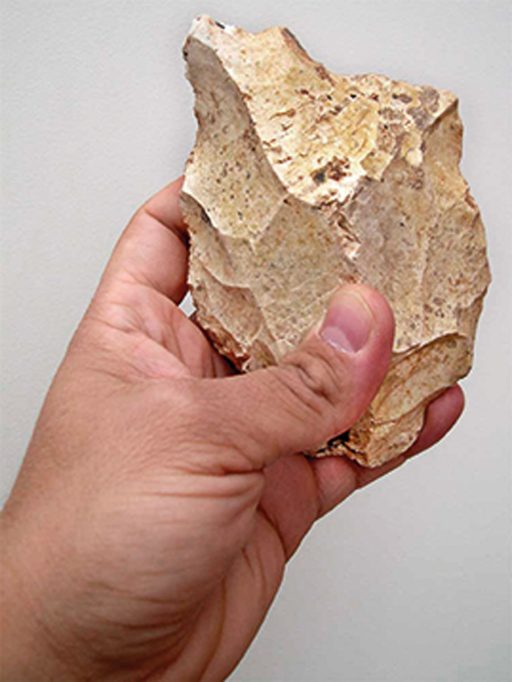
If we could determine whether early hominids learned to make tools by imitation, we could deduce whether species that made stone tools already had cumulative culture 2.6 million years ago. In the picture, a carved stone cutter. / José-Manuel Benito Álvarez
Apes’ spontaneous stone tool making and using abilities
In 2017, the STONECULT project funded by the European Research Council and led by Dr. Claudio Tennie from the University of Tübingen (Germany), set to replicate and expand the previous ape stone tool experiments addressing the limitations outlined above. In a first set of experiments, the spontaneous abilities of unenculturated chimpanzees and orangutans to make sharp stone tools and successfully use them as cutting tools in the absence of demonstrations was investigated (Bandini, Motes-Rodrigo et al., 2021; Motes-Rodrigo et al., 2022).
In these experiments, the apes were provided with all the materials necessary to produce sharp stone tools (a core and hammers) as well as puzzle boxes with food inside that could only be open with a cutting tool. In later tests, the apes were provided with sharp stone tools made by a human which they could use directly or take as examples to make their own. Surprisingly, chimpanzees never engaged in the task despite the fact that they use stone tools for a variety of foraging activities in the wild such as nut-cracking. Even more surprisingly, orangutans, who do not use stone tools in the wild, spontaneously used a human made sharp stone as a cutting tool to open one of the boxes and engaged in lithic percussion, hitting the core against the hard floor of the enclosure. These percussive actions, which the orangutan innovated on his own, led to the production of sharp stone fragments that the orangutan ignored (Motes-Rodrigo et al., 2022).
These experiments revealed that orangutan but not chimpanzees can individually and spontaneously express some of the behavioural prerequisites involved in the production and use of sharp stone tools: orangutans can recognize a sharp stone as a potential tool and use to cut. They also readily engage in lithic percussion, which, probably unintentionally as part of individual play, can lead to the production of sharp stones (see also Bandini, Grossmann et al., 2021, for another example of spontaneous percussion by orangutans in the context of nut-cracking). However, orangutans did not combine these skills on their own; they never made a sharp stone that they subsequently used as a cutting tool. Maybe orangutans needed to imitate a model to learn the entire sequence and maybe chimpanzees needed to imitate a model to learn all behavioural elements. To address these questions, follow-up studies were conducted where chimpanzees and orangutans were provided with demonstrations performed by a human of how to make sharp-stone tools and how to use them before they were granted access to the testing materials – e.g., cores, hammers, and testing boxes. In this new set of experiments (Motes-Rodrigo et al., 2022; Motes-Rodrigo & Tennie, 2023), one orangutan engaged in the demonstrated physical actions required to produce sharp stone tools – hitting the core with a hammerstone – as well as engaged in lithic percussion hitting the hammer against the testing room’s walls producing sharp stones. In the case of the chimpanzees, two individuals used a hammer to softly hit the core but did not detach any sharp stones.
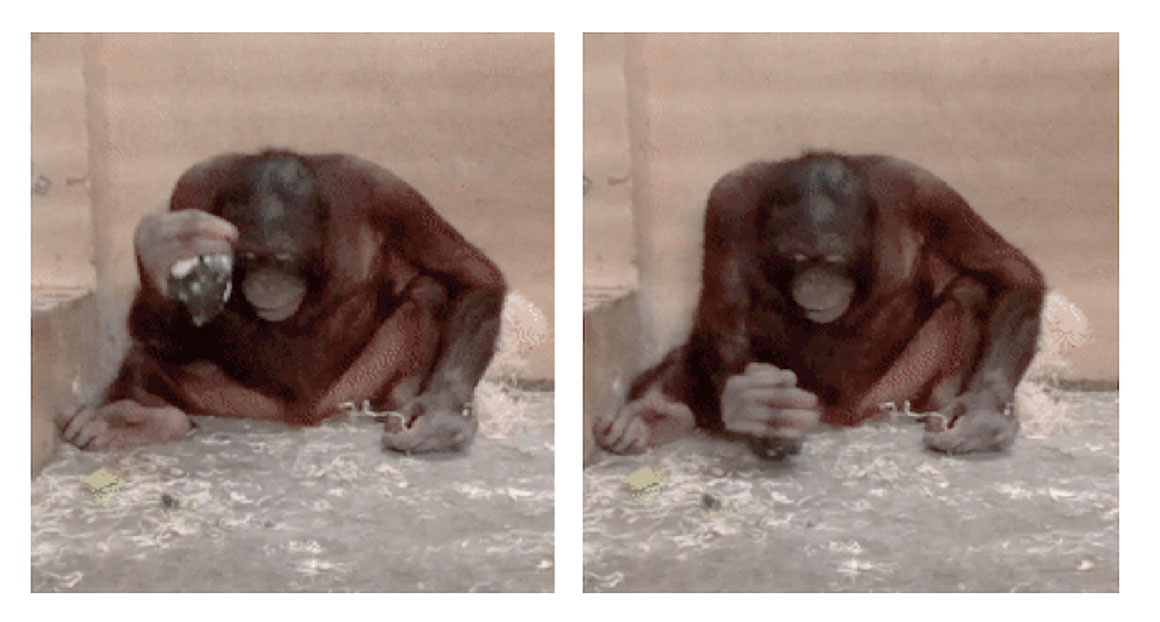
Orangutans can recognise a sharp stone as a potential tool and use it for cutting. They can also perform lithic percussion. However, in the experiments they do not combine these skills on their own: in experiments, they never made a sharp stone that they subsequently used as a cutting tool. Above, two moments from one of the studies (Motes-Rodrigo et al., 2022). / PLOS
Overall these experiments revealed that orangutans – but not chimpanzees – can learn individually without imitating a demonstrator several of the steps required for the development of sharp stone tool-making and -using abilities (e.g., lithic percussion and the use of a sharp stone as a cutting tool). These results open the possibility that the common ancestor of orangutans and humans, who lived around 12 million years ago and shared similar socio-ecological environments with modern orangutans, was also able to perform these behaviours without the need to copy models. The fact that none of the apes tested could combine these abilities and intentionally produce a sharp stone tool for its subsequent use suggests that this behavioural sequence requires cognitive skills, such as imitation, which would have developed later – in the last 6 million years, after the split between the genus Pan and Homo – in the Homo lineage.
Since the publication of these ape studies, new experiments have adapted this methodology to evaluate whether modern humans rely on the same learning mechanisms that sustain cumulative culture when they learn how make and use the oldest types of sharp stone tools found in the archaeological record. Using the same testing materials (puzzle boxes) employed in the ape studies, Snyder et al. (2022) tested whether modern humans that had no previous stone-tool making experience could spontaneously recreate and use stone tools similar to those produced 2.6 million years ago by our ancestor in the absence of guidance, instructions or demonstrations. Out of the 25 participants, 22 spontaneously produced and used sharp stone tools over a four-hour test. These results provide convincing evidence that the earliest techniques used to produce sharp stone tools were likely not part of cumulative cultures and that the origins of cumulative culture happened at a later time in our evolutionary history. The ape studies present above complement these findings by showing that some of the elements of the stone-tool making and use sequence could have been present in the early hominin (or even hominid) repertoire, and could have even been expressed by species that did not regularly use stone tools. In summary, it is very likely that cumulative culture and the learning mechanisms it depends on (imitation) evolved less than 2.6 million years ago but also, that earlier species included in their repertoire stone-related behaviours such as lithic percussion and the opportunistic use of sharp stones.
References
Badihi, G., Graham, K. E., Fallon, B., Safryghin, A., Soldati, A., Zuberbühler, K., & Hobaiter, C. (2023). Dialects in leaf-clipping and other leaf-modifying gestures between neighbouring communities of East African chimpanzees. Scientific Reports, 13(1), 147. https://doi.org/10.1038/s41598-022-25814-x
Bandini, E., Grossmann, J., Funk, M., Albiach‐Serrano, A., & Tennie, C. (2021). Naïve orangutans (Pongo abelii and Pongo pygmaeus) individually acquire nut‐cracking using hammer tools. American Journal of Primatology, 83(9), e23304. https://doi.org/10.1002/ajp.23304
Bandini, E., Motes-Rodrigo, A., Archer, W., Minchin, T., Axelsen, H., Hernandez-Aguilar, R. A., McPherron, S. P., & Tennie, C. (2021). Naïve, unenculturated chimpanzees fail to make and use flaked stone tools. Open Research Europe, 1, 20. https://doi.org/10.12688/openreseurope.13186.1
Boyd, R., & Richerson, P. J. (1996). Why culture is common, but cultural evolution is rare. Proceedings of the British Academy, 88, 77–93.
Braun, D. R., Aldeias, A., Archer, W., Arrowsmith, J. R., Baraki, N., Campisano, C. J., Deino, A. L., DiMaggio, E. N., Dupont-Nivet, G., Engda, B., Feary, D. A., Garello, D. I., Kerfelew, Z., McPherron, S. P., Patterson, D. B., Reeves, J. S., Thompson, J. C., & Reed, K. E. (2019). Earliest known Oldowan artifacts at > 2.58 Ma from Ledi-Geraru, Ethiopia, highlight early technological diversity. PNAS, 116, 11712–11717. https://doi.org/10.1073/pnas.1820177116
Breen, A. J. (2021). Animal culture research should include avian nest construction. Biology Letters, 17(7), 20210327. https://doi.org/10.1098/rsbl.2021.0327
Dean, L. G., Kendal, R. L., Schapiro, S. J., Thierry, B., & Laland, K. N. (2012). Identification of the social and cognitive processes underlying human cumulative culture. Science, 335(6072), 1114–1118. https://doi.org/10.1126/science.1213969
Dean, L. G., Vale, G. L., Laland, K. N., Flynn, E., & Kendal, R. L. (2014). Human cumulative culture: A comparative perspective. Biological Reviews, 89(2), 284–301. https://doi.org/10.1111/brv.12053
Garland, E. C., Garrigue, C., & Noad, M. J. (2021). When does cultural evolution become cumulative culture? A case study of humpback whale song. Philosophical Transactions of the Royal Society B: Biological Sciences, 377(1843), 20200313. https://doi.org/10.1098/rstb.2020.0313
Harmand, S., Lewis, J. E., Feibel, C. S., Lepre, C. J., Prat, S., Lenoble, A., Boës, X., Quinn, R. L., Brenet, M., Arroyo, A., Taylor, N., Clément, S., Daver, G., Brugal, J., Leakey, L. N., Mortlock, R. A., Wright, J. D., Lokorodi, S., Kirwa, C., … Roche, H. (2015). 3.3-million-year-old stone tools from Lomekwi 3, West Turkana, Kenya. Nature, 521, 310–315. https://doi.org/10.1038/nature14464
Laland, K. N., & Hoppitt, W. (2003). Do animals have culture? Evolutionary Anthropology, 12(3), 150–159. https://doi.org/10.1002/evan.10111
Legare, C. H., & Nielsen, M. (2015). Imitation and innovation: The dual engines of cultural learning. Trends in Cognitive Sciences, 19, 688–699. https://doi.org/10.1016/j.tics.2015.08.005
Motes-Rodrigo, A., McPherron, S. P., Archer, W., Hernandez-Aguilar, R. A., & Tennie, C. (2022). Experimental investigation of orangutans’ lithic percussive and sharp stone tool behaviours. PLOS ONE, 17(2), e0263343. https://doi.org/10.1371/journal.pone.0263343
Motes-Rodrigo, A., Mundry, R., Call, J., & Tennie, C. (2021). Evaluating the influence of action- and subject-specific factors on chimpanzee action copying. Royal Society Open Science, 8(2), 200228. https://doi.org/10.1098/rsos.200228
Motes-Rodrigo, A., & Tennie, C. (2023). Ape knapping then and now: Limited social learning of sharp-stone tool production and use in untrained non-human apes. In A. Karakostis & G. Jäger (Eds.), Biocultural implications: An agenda for integrative approaches.
Snyder, W. D., Reeves, J. S., & Tennie, C. (2022). Early knapping techniques do not necessitate cultural transmission. Science Advances, 8(27), eabo2894. https://doi.org/10.1126/sciadv.abo2894
Toth, N., Schick, K. D., Savage-Rumbaugh, E. S., Sevcik, R. A., & Rumbaugh, D. M. (1993). Pan the tool-maker: Investigations into the stone tool-making and tool-using capabilities of a bonobo (Pan paniscus). Journal of Archaeological Science, 20, 81–91. https://doi.org/10.1006/jasc.1993.1006
Wright, R. V. S. (1972). Imitative learning of a flaked stone technology — The case of an orangutan. Mankind, 8, 296–306. https://doi.org/
10.1111/j.1835-9310.1972.tb00451.x
Zandberg, L., Lachlan, R. F., Lamoni, L., & Garland, E. C. (2021). Global cultural evolutionary model of humpback whale song. Philosophical Transactions of the Royal Society B: Biological Sciences, 376(1836), 20200242. https://doi.org/10.1098/rstb.2020.0242


